22 august 2007
- Tiananmen Square

The Tiananmen Square in the center
of Beijing, is said to be the biggest
square in the world. It is has a total
area of 440,000 square meters and
can hold one million people.
The granite Monument to the People’s
Heroes is just at the center of the
Tiananmen Square. Built in 1952, it is
the largest monument in China’s history.
- Forbidden City
The Forbidden City, located at the center of the ancient city of Beijing, was home to 24 emperors during the Ming and Qing dynasties. Surrounded by a six meter deep, and a ten meter high wall are 9,999 buildings. Construction of the palace complex began in 1407 and was completed fourteen years later in 1420.

Today, the Forbidden City is a World Heritage. At the Forbidden City you can see the traditional architecture up close and marvel at the treasures of the imperial family and its court.

20 august 2007
- Summer Palace

The Summer Palace has a history of over 850 years. The Imperial garden has existed since 1150. The gardens that surrounded the Summer Palace date from the Jin Dynasty (1115-1234).

The Summer Palace was used as a summer residence by China’s Imperial rulers, as a retreat from the main imperial palace now known as the Forbidden City. For the emperor the summer palace was a pleasure ground in the countryside, yet near to the city.

18 august 2007
- Old Summer Palace
The gardens of the Old Summer Palace, which are about the same size as Central Park in New York, date back to the 12th century. Emperor Qianlong who was inspired by French and Italian palaces and had 10 palaces of his own designed and built in rococo style in the gardens.
When the British and French were unhappy with the Chinese government’s refusal to accept opium in return for silk, tea and other goods, the Europeans destroyed the 10 palaces of the emperor. The destruction occurred over three days in 1860 during the Second Opium War (1860-1862). The troops burned all the wood structures and did as much damage to the marble facades as they could.
The Old Summer Palace which is known as the Ruins of the Yuanmingyuan (the Garden of Perfection and Light) was also called the ‘garden of gardens’ or the ‘Versailles of the East’ in Europe. Hundreds of scenic spots in the Garden are made up of exquisitely constructed, earth and rock hills, rivers and ponds, exotic flowers and grasses, Grand Waterworks, and a Labyrinth. The Old Summer Palace embodies the essence of Chinese ancient landscape gardening.
15 august 2007
- Great Wall / Chinese Wall
To reach Mutianyu Great Wall there are more than 1,400 steps to climb. Mutianyu Great Wall enjoys a long history and is part of the glorious culture of China.
The wall was first built in Northern Qi Dynasty (550 - 557). In the Ming Dynasty (1368 - 1644), Tan Lun and Qi Jiguang, two famous patriotic generals, rebuilt it in order to strengthen its defensive potential when they guarded the strategic pass. Mutianyu Great Wall winds 1.4 miles through lofty mountains and high ridges, many sections of which are made of granite.
The unique structure makes the wall almost indestructible. There are 22 watch towers distributed at close intervals along the wall.
“He who has not climbed the Great Wall is not a true man.” - Mao Zedong
14 august 2007
- Beihai Park
Beihai Park is one of the oldest, largest and best-preserved ancient imperial gardens in China located in the center of Beijing.
This ancient garden, with over 1,000 years’ history, is not only a classic combination of the grandiosity of the northern gardens and the refinement of the southern gardens in China, but also a perfect integration of magnificent imperial palaces and solemn religious constructions.
- Beihai Park, Nine-Dragon Screen
The well-known Nine-Dragon Screen, which is the only screen in the world having nine huge dragons on both sides among the most famous three. The Nine-Dragon Screen is about 27 meters (about 88.6 feet) long, 6.65 meters (about 21.8 feet) high and 1.42 meters (4.66 feet) thick.
The Nine-Dragon Screen is still bright in color and complete in appearance, showing the high techniques of Chinese arts and crafts in ancient times.



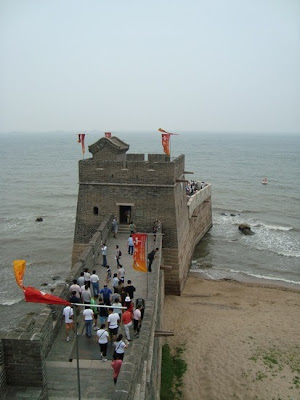



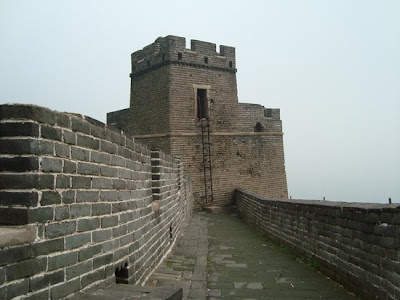
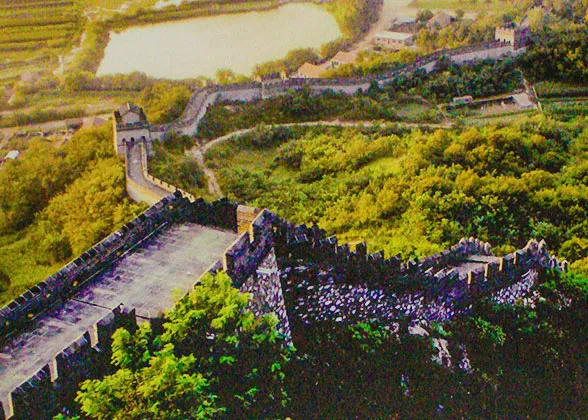 The construction of defensive walls has a long history in China. Early in the Spring and Autumn Period, every state was active in buildingprotective walls against their enemies. Yan State was no exception.As it was one of the seven powerful warring states at the time.The western region of today's Liaoning Province is proved to be under the jurisdiction of Yan State, so here one can find manyrelics of the wall. The wall of Yan State in Jianping County is said to be the earliest wall in Liaoning, which was originallycalled "earth dragon" or the "stone dragon" bythe local inhabitants.
The construction of defensive walls has a long history in China. Early in the Spring and Autumn Period, every state was active in buildingprotective walls against their enemies. Yan State was no exception.As it was one of the seven powerful warring states at the time.The western region of today's Liaoning Province is proved to be under the jurisdiction of Yan State, so here one can find manyrelics of the wall. The wall of Yan State in Jianping County is said to be the earliest wall in Liaoning, which was originallycalled "earth dragon" or the "stone dragon" bythe local inhabitants.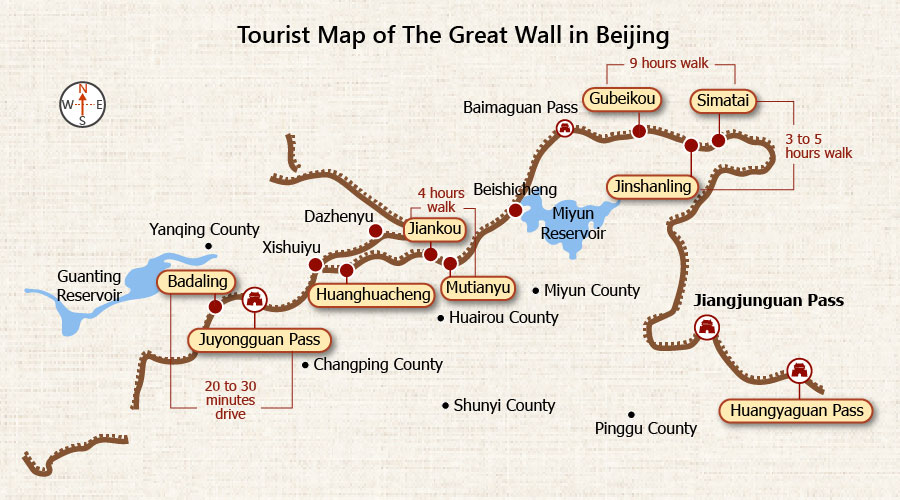

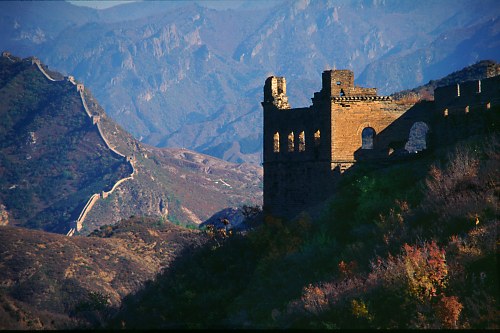
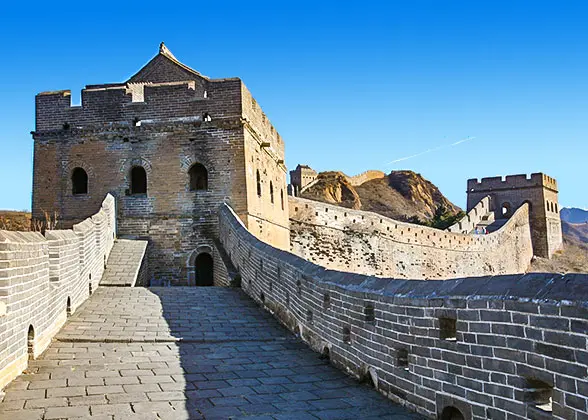 Beacon towers : Beacon towers were used for passing military messages. They were often built on the tops of the mountains or rises for convenience in watching the enemies’ movements. Due to its unique function, it is regarded as the oldest effective telegraph system in Chinese history.
Beacon towers : Beacon towers were used for passing military messages. They were often built on the tops of the mountains or rises for convenience in watching the enemies’ movements. Due to its unique function, it is regarded as the oldest effective telegraph system in Chinese history.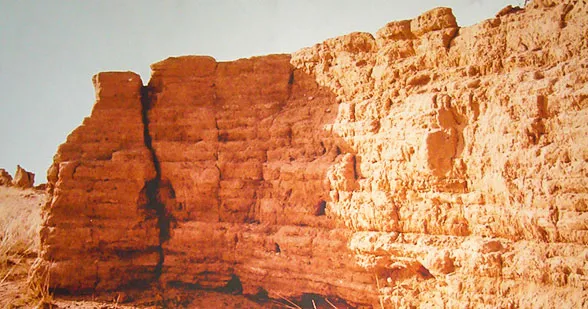 Walls : Walls are the main part of the construction, averaging about 26.6 feet tall. They serve as the important nexus connecting the passes, beacon towers, watch towers and other military structures together, thus allowing the dragon to fly freely over the vast land of northern China.
Walls : Walls are the main part of the construction, averaging about 26.6 feet tall. They serve as the important nexus connecting the passes, beacon towers, watch towers and other military structures together, thus allowing the dragon to fly freely over the vast land of northern China.
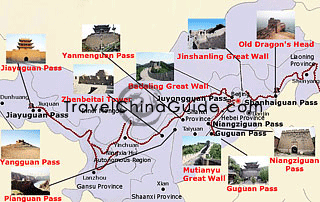
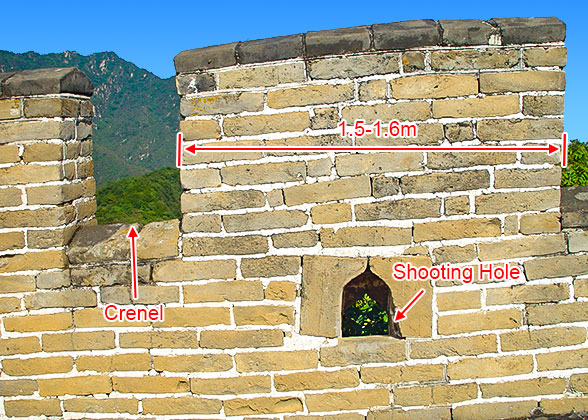 The Qin Wall starts from Liaodong (today's east and south of Liaoning Province) in the east and ends at Lintao (today's Lintao County in Gansu Province) in the west. The wall was built according to the local conditions and used local materials. Generally speaking, the Qin Wall was made of large pieces of stones. Between the stones, huge amounts of detritus was accumulated and filled in. It measures about 4.4 to 5.5 yards. The steep cliffs were used as natural walls after being chiseled a little. In Gobi area, the wall was built by mixing grit with the local plants such as red willows, reeds, and poplars. In flat plains, the wall was built from pounded yellow earth, layer upon layer. Besides connecting the scattered sections of previous states, Qin Wall was augmented with rather complicated military structures such as blockhouses, barriers, passes and beacon towers.
The Qin Wall starts from Liaodong (today's east and south of Liaoning Province) in the east and ends at Lintao (today's Lintao County in Gansu Province) in the west. The wall was built according to the local conditions and used local materials. Generally speaking, the Qin Wall was made of large pieces of stones. Between the stones, huge amounts of detritus was accumulated and filled in. It measures about 4.4 to 5.5 yards. The steep cliffs were used as natural walls after being chiseled a little. In Gobi area, the wall was built by mixing grit with the local plants such as red willows, reeds, and poplars. In flat plains, the wall was built from pounded yellow earth, layer upon layer. Besides connecting the scattered sections of previous states, Qin Wall was augmented with rather complicated military structures such as blockhouses, barriers, passes and beacon towers.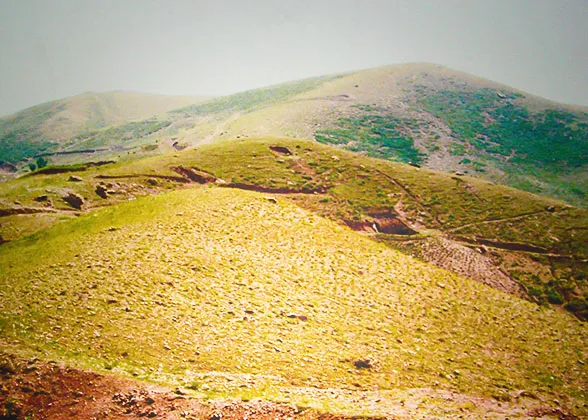 Han Wall followed the basic characteristic of Qin Wall, that is, to build the wall according to the local conditions and used local materials. The difference lies in the constructional types. The Han Wall mainly wound through grasslands where big stones were not available. The compressed earth construction was favored. For example, in Dunhuang, where large amount of bulrush, poplar, red willow and dogbane grew, these were used for wall construction. The branches of these plants served as groundwork which was covered by a layer of sun-dried mud bricks mixed with grit and above was the rammed bulrush. On average, the thickness of the bulrush layer measured 1.6 to 2.0 inches and the grit layer measured 7.9 inches. Remnants of this work remain till this day. The willow branch and bulrush could bear strong tension, and stones and grit were not easy to be destroyed after being compacted in layers, so the wall became rather solid.
Han Wall followed the basic characteristic of Qin Wall, that is, to build the wall according to the local conditions and used local materials. The difference lies in the constructional types. The Han Wall mainly wound through grasslands where big stones were not available. The compressed earth construction was favored. For example, in Dunhuang, where large amount of bulrush, poplar, red willow and dogbane grew, these were used for wall construction. The branches of these plants served as groundwork which was covered by a layer of sun-dried mud bricks mixed with grit and above was the rammed bulrush. On average, the thickness of the bulrush layer measured 1.6 to 2.0 inches and the grit layer measured 7.9 inches. Remnants of this work remain till this day. The willow branch and bulrush could bear strong tension, and stones and grit were not easy to be destroyed after being compacted in layers, so the wall became rather solid.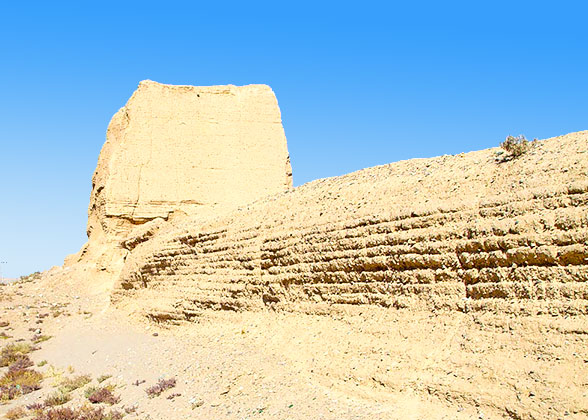 The military system of Han Wall included barriers, beacon towers, strongholds, trenches, castles besides passes and blockhouses. Tiantian, a newly created observation object, was built by placing a layer of silver sand inside the trench. If the Huns dared to set foot in, they would certainly leave footprint on the sand, which would be noticed by sentries. Besides, the strict beacon system was formed in Han Dynasty. The regulation prescribed that a beacon be built at the interval of 1.6 miles, a block at the interval of 3.1 miles, a fortress at the interval of 18.6 miles and a pass at the interval of 62.1 miles. In the daytime, smoke columns were used to warn the coming of attacks. One smoke column indicated that less than one thousand enemies invaded, if more than one thousand enemies attacked, two smoke columns would be raised. Three smoke columns would be lifted in case more enemies came. At night, soldiers would kindle firebrands to warn of coming dangers.
The military system of Han Wall included barriers, beacon towers, strongholds, trenches, castles besides passes and blockhouses. Tiantian, a newly created observation object, was built by placing a layer of silver sand inside the trench. If the Huns dared to set foot in, they would certainly leave footprint on the sand, which would be noticed by sentries. Besides, the strict beacon system was formed in Han Dynasty. The regulation prescribed that a beacon be built at the interval of 1.6 miles, a block at the interval of 3.1 miles, a fortress at the interval of 18.6 miles and a pass at the interval of 62.1 miles. In the daytime, smoke columns were used to warn the coming of attacks. One smoke column indicated that less than one thousand enemies invaded, if more than one thousand enemies attacked, two smoke columns would be raised. Three smoke columns would be lifted in case more enemies came. At night, soldiers would kindle firebrands to warn of coming dangers.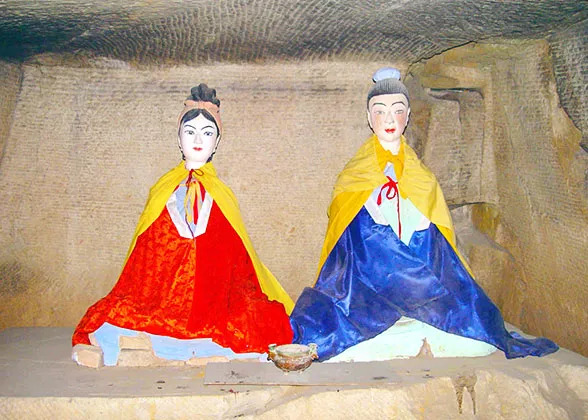 The Ming Wall is the solidest and most complete one compared with walls in other dynasties. The Ming Dynasty drew the experience from the previous dynasties when they built the wall. More important military fortifications were added on the wall. In flat areas, outside the wall, big wide moats were dug to make approach difficult.
The Ming Wall is the solidest and most complete one compared with walls in other dynasties. The Ming Dynasty drew the experience from the previous dynasties when they built the wall. More important military fortifications were added on the wall. In flat areas, outside the wall, big wide moats were dug to make approach difficult.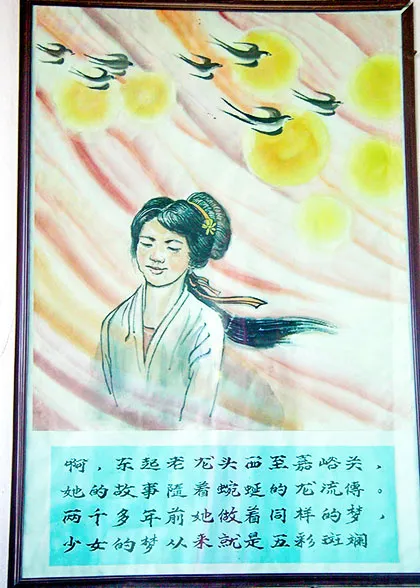 Watch towers were often square in shape and towered above the top of the wall about 13.1 feet. While at places of strategical importance, the watch towers were round and raised high above the wall. They were built for soldiers to live in, to store food and weapons for a long period of time. The Ming Dynasty still raised smoke to warn of dangers. Besides, the boom of cannon was added to strengthen the alarm effect. In ancient times when telephone and wireless communication were not available, this method to transfer the military message was obviously fast. Beacon towers in Ming Wall were also used for ensuring the safety of ambassadors, supplying them with room and board and offering forage for their horses.
Watch towers were often square in shape and towered above the top of the wall about 13.1 feet. While at places of strategical importance, the watch towers were round and raised high above the wall. They were built for soldiers to live in, to store food and weapons for a long period of time. The Ming Dynasty still raised smoke to warn of dangers. Besides, the boom of cannon was added to strengthen the alarm effect. In ancient times when telephone and wireless communication were not available, this method to transfer the military message was obviously fast. Beacon towers in Ming Wall were also used for ensuring the safety of ambassadors, supplying them with room and board and offering forage for their horses.





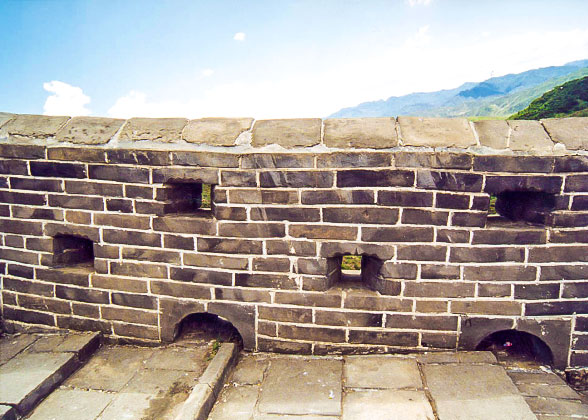 The winding Great Wall is not merely a wall but instead a complete and rigorous defense project composed of countless passes, watchtowers, garrison towns, beacon towers and blockhouses. These fortifications were arranged in certain ways under the control of the military command system at all levels. For example, there were about 1,000,000 soldiers guarding the Ming’s wall. The chief military officers were stationed in garrison-towns, while lesser officials and soldiers were stationed in Guan Cheng (the defensive beachhead) and other smaller fortifications. The eleven garrisons were set up along the wall in order to guard the precinct or subsection. The average height of the Ming wall measures 33 feet and the width is about five yards. In low, flat areas the wall was built high and more defense lines were added. In the lofty mountains, the wall was a little lower in order to save the human and financial cost. Sometimes, even steep cliffs served as natural walls to thwart enemies.
The winding Great Wall is not merely a wall but instead a complete and rigorous defense project composed of countless passes, watchtowers, garrison towns, beacon towers and blockhouses. These fortifications were arranged in certain ways under the control of the military command system at all levels. For example, there were about 1,000,000 soldiers guarding the Ming’s wall. The chief military officers were stationed in garrison-towns, while lesser officials and soldiers were stationed in Guan Cheng (the defensive beachhead) and other smaller fortifications. The eleven garrisons were set up along the wall in order to guard the precinct or subsection. The average height of the Ming wall measures 33 feet and the width is about five yards. In low, flat areas the wall was built high and more defense lines were added. In the lofty mountains, the wall was a little lower in order to save the human and financial cost. Sometimes, even steep cliffs served as natural walls to thwart enemies.




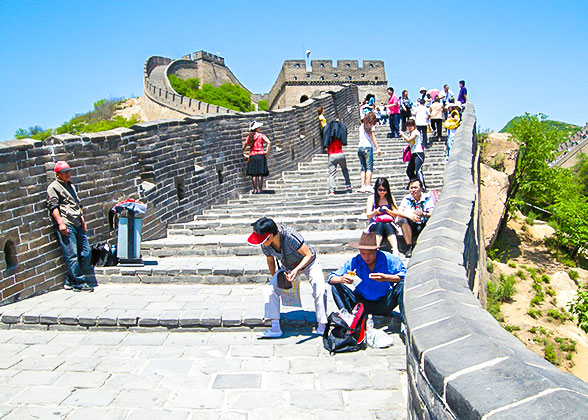 Soldiers made up the main construction group. This was the case with the building of the wall of Northern Qi (550-557). Also, during the Qin Dynasty (221BC - 206BC), 300,000 soldiers were redirected to build the wall after General Meng Tian conquered the Huns. Still, it took nine years to finish the work. In order to take care of the soldiers and make them feel settled, the court even arranged for widows to marry them.
Soldiers made up the main construction group. This was the case with the building of the wall of Northern Qi (550-557). Also, during the Qin Dynasty (221BC - 206BC), 300,000 soldiers were redirected to build the wall after General Meng Tian conquered the Huns. Still, it took nine years to finish the work. In order to take care of the soldiers and make them feel settled, the court even arranged for widows to marry them.